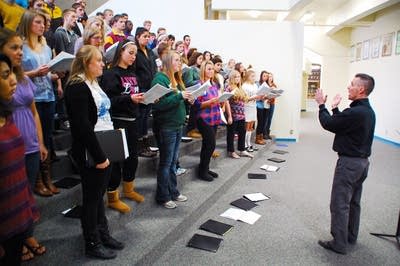Study: Many Minnesota schools struggle to meet arts education mandates
Go Deeper.
Create an account or log in to save stories.
Like this?
Thanks for liking this story! We have added it to a list of your favorite stories.

Minnesota has some of the highest standards for arts education in the country, but schools don't always meet those lofty expectations.
As schools work to increase student test scores in math, science and reading, arts education is often pushed aside, according to a survey to be released today by the Perpich Center for Arts Education.
According to the survey, fewer than half of all middle and high schools, and only 28 percent of elementary schools offer all of the required arts, drama, music and dance classes.
Even in school districts that are committed to providing arts education on par with math, science and reading, there have been subtle shifts that have affected the arts.
Turn Up Your Support
MPR News helps you turn down the noise and build shared understanding. Turn up your support for this public resource and keep trusted journalism accessible to all.
The Rosemount-Apple Valley-Eagan district, for example, has pushed students into more English, math and science classes.
That's left students with less time for elective options, like band and choir.
"That obviously is going to impact the number of kids who are coming into the high school signing up for arts classes such as choir or art," said Joe Wycoff, Apple Valley High School's director of arts, activities and testing. "So yes, it has had an impact that we're trying to struggle through."

Still, the arts play a big role in student life at Apple Valley High School. That's obvious during a walk through the halls, where 70 voices bounce off the walls outside the school's theater as one of several student choirs practices for an upcoming concert.
Along with choir, students at Apple Valley High School are able to take classes in band, theater, visual arts and dance.
Choir teacher Bill Blatzheim said it's part of the school's philosophy to offer a hearty helping of the three As - academics, arts and athletics.
"It really is something that we do different here that isn't done everywhere and we're pretty proud of it," he said.
But with fewer students enrolling in arts classes, Apple Valley High School has cut staff. The school has six teaching positions in its arts program, down from 10 five years ago.
The age-old tussle between arts and academics is the focus of the statewide study from the Perpich Center for the Arts. Some schools now fall short of meeting state mandates for arts education, largely because of changing budget priorities, said Sue Mackert, the center's executive director.
As schools shift resources to improve test scores, arts classes are often the first to go.
"When they're trying to balance budgets and programs, it's sometimes easy to make decisions that put the things like arts education at risk," Mackert said.
It's a move that can make the most sense for school administrators. That's in part because the high stakes testing ultimately ranks the performance of the state's schools. Those tests don't consider students knowledge of the arts.
"Of course it's just natural when schools are judged and primarily held accountable for their scores in math and reading that that is where they're going to really direct their resources and protect those resources maybe above others when they have to make budget cuts," said Scott Croonquist, executive director of the Association of Metropolitan School Districts.
The authors of the Perpich study argue that music, drama and other arts should be elevated to the same academic level as math, science and reading.
That means schools should be held accountable for their arts education offerings, perhaps by requiring them to test students on the arts. They also want the state to better fund arts programs at schools, a goal that resonates with Minnesota teachers.
"I think it's really important that our state and our school districts realize that they need to fund and support the arts just as strongly as they fund math and reading," said Kris Holsen, an elementary art and theater teacher in Brooklyn Park and president-elect of the Arts Educators of Minnesota.
Research shows students involved in music, art and drama, do better in math, science and reading, Holsen said.
---
• Follow Tim Post on Twitter: http://www.twitter.com/timpostmpr
Dear reader,
Your voice matters. And we want to hear it.
Will you help shape the future of Minnesota Public Radio by taking our short Listener Survey?
It only takes a few minutes, and your input helps us serve you better—whether it’s news, culture, or the conversations that matter most to Minnesotans.




